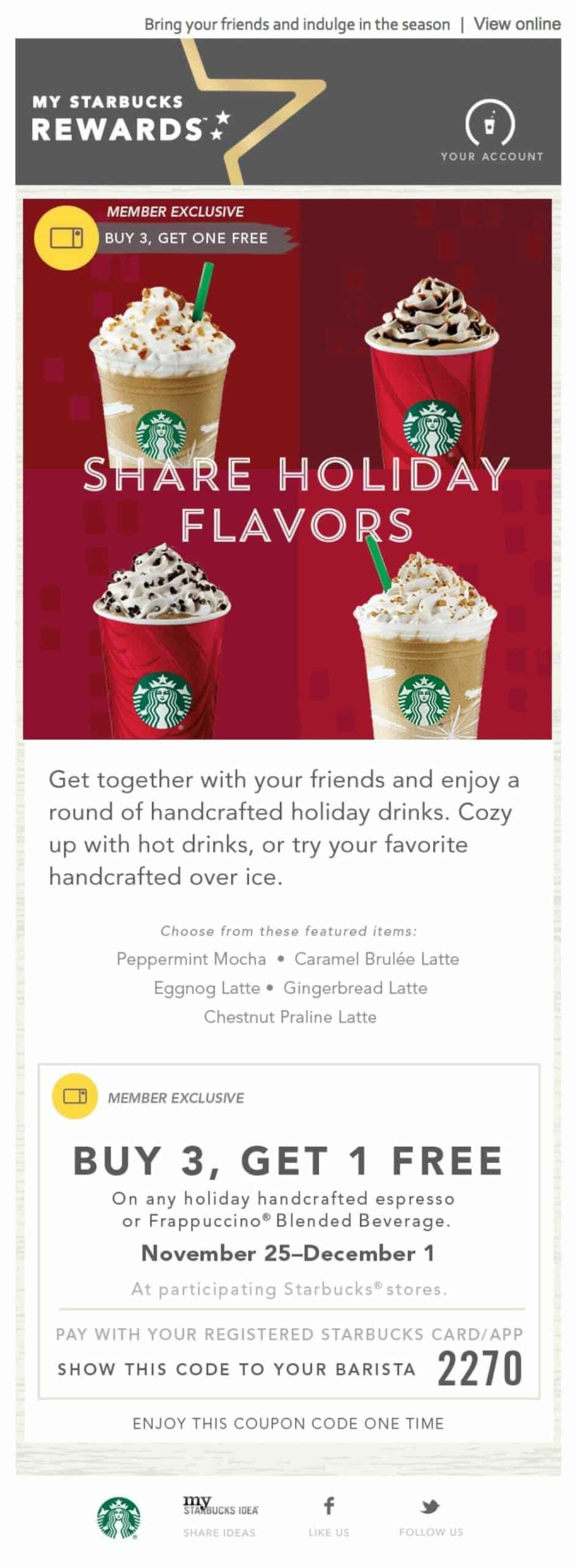
December 1,2023
5 Winning Examples of Promotional Email Mastery
Promotional emails are one of the cornerstones of a successful ecommerce email marketing strategy. They play a pivotal role in driving sales, increasing revenue, and engaging with your customer base. In this article, we’ll explore the vital role of promotional emails in the ecommerce world and the key reasons why they are so crucial for businesses, as well as look at some examples of good promotional email practices.
Content list:
What are promotional emails?
A promotional email is an email sent to ‘inform an email list of new or existing products and offers’. One of the primary benefits of promotional emails lies in their ability to generate awareness and interest. By strategically crafting compelling content, these emails captivate recipients’ attention, drawing them in with enticing subject lines, eye-catching visuals, and persuasive copy.
Some examples of promotional emails for ecommerce would include ‘limited time offers’ or ‘product launch emails’ both of which are used to entice and educate a customer on a specific company’s products.
So what are promotional emails good for?
Boosting Sales and Revenue
At the heart of ecommerce, lies the need to generate sales and revenue. Promotional emails are a powerful tool for achieving these objectives, here’s how they can help with this:
Limited-Time Offers: Promotional emails often feature limited-time offers, discounts, or exclusive deals. These create a sense of urgency, compelling customers to make a purchase sooner rather than later.
Cross-Selling and Upselling: Promotions allow you to cross-sell related products or upsell to higher-value items. This increases the average order value and maximises revenue from each customer.
Clear Call-to-Actions (CTA): Effective promotional emails include a clear and compelling call-to-action button that guides recipients to take the desired action, such as “Shop Now” or “Claim Your Discount.” which in turn can help to boost sales.
Building Customer Loyalty
Promotional emails also play a significant role in building and nurturing customer loyalty. Here’s how they contribute to this important aspect of ecommerce:
Rewards and Exclusive Offers: By offering special discounts or rewards exclusively to your email subscribers, you demonstrate that you value and appreciate their loyalty.
Personalisation: Promotional emails can be personalised based on customer behaviour and preferences. This personal touch can make customers feel more connected to your brand.
Consistency: Sending out regular promotional emails helps to keep your brand in the minds of your customers. Consistency in promotions can lead to recurring sales and long-term customer relationships.
Now that we’ve looked into how promotional emails can help, let’s take a deeper dive into the different types of promotional emails.
Seasonal email promotions
Seasonal or holiday promotions emails are a powerful marketing tool for several reasons. Firstly, they tap into the emotional connection people have with specific times of the year, making them more receptive to offers and discounts.
Secondly, these emails create a sense of urgency, encouraging immediate action. They also help businesses stand out in a crowded market, as consumers actively seek out holiday-themed deals. These promotional emails can boost customer loyalty and engagement.
The thing to remember is that a seasonal email promotion should be engaging, compelling, and tailored to resonate with your audience. The below example is a great demonstration of these points.

(source)
The thing we like about this email is its simplicity. It’s very easy to follow and the visuals speak for themselves. This email is clearly promoting holiday themed drinks. It’s also a great demonstration of exclusivity, as this email is specific for members only, making it feel like it’s for special select people. It shows that being a member holds benefits, in this instance ‘buy 3, get 1 free’ also helping to drive membership sign ups.
Limited Time Offers
Another great example of promotional emails are ‘limited time offers (LTO)’. One of the reasons these are so effective is because of the urgency and ‘act now’ behaviour that they reinforce.
Limited time offers utilise feelings of FOMO which can help to motivate an audience to act before promotions expire. In fact, one study found that ‘companies can increase conversions by making their audience feel like they need to act quickly’.

As is demonstrated in the email above, one limited offer you will see a lot of are ‘Black Friday Deals’. While Black Friday lasts a lot longer than it once did, there is still a sense of urgency that comes with sending out these emails.
Above was an email I received from Currys. What’s good about this email is that it gets straight to the point. The subject line tells me everything I need to know about this email – ‘Your early access to black friday is here’ this emphasises the exclusivity and advantage this email offers to the recipient. Promoting the”early access,” the benefit conveyed is that the recipient gets a head start on Black Friday deals before the general public. This creates a sense of privilege and urgency, allowing the recipient to potentially secure sought-after items, access limited deals, or make purchases before products sell out or prices increase.
This email utilises FOMO, by emphasising that you should use this email to beat the queues before everyone can access their deals, it’s a great way of getting their Black Friday deals in with clients before other companies can.
Limited time promotional emails are an effective marketing strategy due to their ability to create a sense of urgency, drive immediate action, and encourage customer engagement while also fostering loyalty and boosting sales!
Re-engagement
The main thing to remember with promotional emails is that not all of your emails will appeal to every customer. For example, re-engagement is less likely to resonate with someone that is already actively purchasing from your store. Instead, you should use these emails to ‘win back’ customers.
Re-engagement emails target inactive or dormant customers who haven’t interacted with your brand for a while. Sending personalised and enticing offers can reignite their interest, prompting them to return to your ecommerce store and make a purchase. This helps in reactivating a portion of your customer base that might have otherwise been lost.
Furthermore, through re-engagement campaigns, you gain valuable insights into customer behaviour. Analysing responses to these emails—such as open rates, click-through rates, and conversion rates—provides data on what works and what doesn’t. This data helps in refining future marketing strategies and improving overall customer engagement tactics.

(Source)
Above is a great example of a re-engagement email. One thing we love about it is how straight off the bat you are hit with both a discount and then some possible products that this could be applied to.
This makes the buying experience easy to follow. This email also acknowledges that this customer has had previous interactions with this brand, therefore showing appreciation and possibly rekindling their interest.
In summary, re-engagement promotional emails can help ecommerce businesses reactivate dormant customers.
Product Launch
Product release promotional emails are a powerful tool for ecommerce businesses, offering numerous advantages.
Drive interest to your brand: Sending out product launch emails generates anticipation among your audience. By teasing the upcoming product with sneak peeks, teasers, or exclusive information, you build excitement and curiosity, driving interest in your brand and product.
Incentivise action: With product launch emails, often, they will offer early access or pre-order opportunities to subscribers, such as exclusive access or special discounts for early adopters. This can incentivise immediate action, encouraging customers to make purchases before the official release.
Higher engagement and conversion rates: Product launch emails allow for targeted segmentation based on customer preferences or purchase history. Tailoring these emails to specific segments of your audience ensures that recipients receive information about products they’re likely to be interested in, leading to higher engagement and conversion rates.

(Source)
What we love about the above example is how it demonstrates the benefits of interaction. It shows that a customer vote has resulted in this product. This email utilises imagery and buttons to guide their viewer to take action.
Using personalisation in promotional emails is always beneficial, but specifically for a product launch there are a range of benefits to be had.
Such as, highlighting new products can showcase your brand’s commitment to staying relevant and meeting customer needs, reinforcing your brand authority and building trust among your audience.
New Arrivals
Leveraging new arrivals in promotional emails helps in capturing attention, creating urgency, and gaining insights into customer preferences, which can contribute to increased brand visibility and revenue.
Highlighting new arrivals in promotional emails can instantly capture the attention of subscribers. People are naturally curious about fresh products or collections, making it an effective way to pique their interest and encourage them to engage with your email content.
Additionally, regularly showcasing new products can help to keep your audience engaged and interested in your brand. If you look forward to discovering the latest offerings you might be more likely to consistently open and engage with promotional emails, leading to increased brand loyalty.

(source)
Mac introduces a range of new arrivals with this sleek email. Something that’s great about this is its use of imagery. This email utilises the imagery of a popular designer, it’s likely that the members signed up to this will have an idea of who she is. Using this familiarity is a great way to boost brand awareness as it demonstrates that they partner with many popular artists.
In addition, the email promptly showcases all the products through visual imagery. Moreover, it provides recipients with various ways to engage with the email, such as initiating a shopping session or contacting an artist. This direct and transparent approach exemplifies the brand’s commitment.
Final thoughts
In conclusion, promotional emails remain an indispensable asset for modern marketing strategies and ecommerce stores, offering a range of benefits that significantly contribute to a brand’s success.
Their utility in generating awareness by delivering targeted and personalised content directly to people’s inboxes serve as potent tools for showcasing products, sharing exclusive offers, and nurturing ongoing relationships with customers.
Additionally, for any ecommerce business the data that can be gathered by email marketing can offer valuable insights. This allows brands to continually refine and enhance their strategies for improved customer engagement and increased conversions. In essence, promotional emails stand as a cornerstone of effective digital marketing, offering a direct pathway to connect with audiences and drive business growth in today’s competitive landscape.




